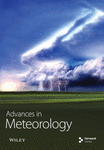Temporal Dynamics and Trend Analysis of Areal Rainfall in Muger Subwatershed, Upper Blue Nile, Ethiopia
Abstract
This study was employed to investigate the temporal variability and trend analysis of areal rainfall in the Muger subwatershed, Upper Blue Nile, Ethiopia. The study was run over the following procedures to handle the main objective: (1) determining the areal rainfall from gauged point rainfall using the Thiessen polygon method, (2) grouping the months in the season according to the study area, (3) evaluating the temporal dynamics of annual and seasonal areal rainfall using the coefficient of variation (CV), standard anomaly index (SAI), and precipitation concentration index (PCI), and (4) analyzing the trend of annual and seasonal areal rainfall using modified Mann–Kendall’s (modifiedmk) test in RStudio. Based on the temporal variability analysis, CV results depict that annual and summer areal rainfall had low variability with values of 13.43% and 13.7%, respectively. Winter and spring areal rainfall shows high variation with a CV value of 50.5% and 36%, respectively. According to the SAI output, around 70% of the considered year was in the normal condition of wetness. On the other hand, the seasonal (winter, spring, and summer) rainfall distribution of the study area shows strong irregularity distribution throughout the considered years as a result of PCI with a value of 57.5%. The trend of the areal rainfall was shown to be both increasing and decreasing. However, the trend was insignificant with a 10% confidence level.
1. Introduction
Rainfall is one of the most important variables that affect both the spatial and temporal availability of fresh water in specific regions [1]. Variability of rainfall influences water-dependent activities of human beings especially rain-fed agricultural activity [2–5]. Nowadays, examining the variability and trends of weather over space and time is becoming an area of serious concern. Previous studies conducted on climate variability, for example, Larbi et al. [6], Taxak et al. [7], Asfaw et al. [8], Miheretu [9], Adugna et al. [10], Kale and Nagesh Kumar [11], Bekuma et al. [12], Hussain et al. [13], Birara et al. [14], Ma et al. [15], Serrano-Notivoli et al. [16], and Takano-Rojas et al. [17] stated the significances of serious examination and monitoring of potential impacts and planning of possible adaptation strategies in different sectors.
Moreover, Duan et al. [18] studied the annual, seasonal, and monthly precipitation trends for the northern Japanese Island of Hokkaido using the Mann–Kendall test and geostatistical interpolation techniques. This study revealed that most stations are with declining trends and among these, almost all of the stations showed increasing trends in May and July. Another study provides insight into the most refined trend on monsoon rainfall at different spatial scales in India using a multimethod approach consisting of the linear regression model (LRM), Mann–Kendall test (MKT), and innovative trend analysis (ITA) analyzed in particular and synchronized way [19]. Additionally modified Mann–Kendall’s test, Sen’s slope test, Weibull’s recurrence interval, Pearson’s coefficient of skewness, consecutive disparity index, and kurtosis are included to evaluate the trends of the West Coast Plain and Hill Agroclimatic Region of India [20]. Mann–Kendall’s and Sen’s slope tests are the most widely applied approaches used for trend analysis in different parts of the world [21–23].
Rainfall in Ethiopia shows high variability across space and time [24–26]. It is characterized by wet and long rainy seasons on the one hand and dry and short rainy seasons on the other hand. Consequently, the high and low rainfall phenomena can give rise, respectively, to flood and drought conditions with adverse economic and humanitarian crises [27]. In Ethiopia, agricultural practice is dependent on rainfall [10, 12, 24, 28].
There are three seasons in Ethiopia. These are the June–September (main rainy season, locally known as Kiremt); the March–May (short rainy season, locally known as Belg); and the October–February (dry season, locally known as Bega) [29]. Understanding the characteristics of Kiremt and Belg season rainfall is important to improving agricultural productivity and mitigating food security challenges and water resource development of the country. Belg and Bega seasons rainfall are more variable than that of Kiremt rainfall which is the largest in terms of its amount and geographical coverage. Therefore, the Belg season crops and the food security of households may highly be affected by high temporal and spatial variability of Belg season rainfall. Kiremt season rainfall supports the main cropping season production, locally known as Meher. The change and shift in Belg season rainfall led to devastating droughts affecting socioeconomic welfare and environmental resources.
Various scholars conduct a trend analysis of rainfall for single or group stations on a local and regional level. Therefore, monthly, seasonal, and annual variability and trend analysis of rainfall is not new in Ethiopia. However, most of these studies are considering the point of rainfall. The main objective of this study was to evaluate seasonal and annual variability and trend analysis of areal rainfall recorded in the last 40 years (1980–2019) in the Muger subwatershed.
2. Materials and Methods
2.1. Study Area Description
The study area, Muger subwatershed, is a part of Upper Blue Nile situated between 37°54′42.57″ to 39°01′24.16″E longitude and 9°04′55.54″ to 9°58′04.64″N latitude in the western part of Ethiopia and includes Wera Jarso, Kuyu, Degem, Gerar Jarrso, Debre Libanos, Wuchale, Jida, Sululta, Mulo, Adda Berga, Meta Robi, Jeldu, Ejere, Walmara, Dendi, and Abuna G/Beret woredas of Oromia region as shown in Figure 1 prepared by the geographical information system (GIS). The Muger watershed covers a drainage area of 7290 km2 and joins the Blue Nile River at 37.93°E and 9.92°N.
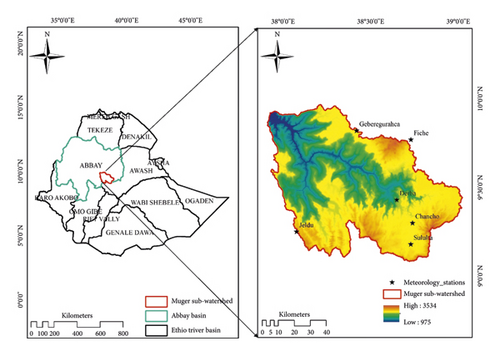
The altitude of the study subwatershed ranges from 975 m to 3534 m asl. The average annual rainfall gauged in the Muger subwatershed ranged from 1099.6 mm at Fiche station to 1536 mm at Chancho station. The socioeconomic activity of the society in this subwatershed depends on rain-fed agriculture during the period from April to September. The climate of the study area is characterized by three seasons, October–February is named winter (Bega), March–May is named spring (Belg), and the summer (Kiremt) season is extended from June–September.
2.2. Data Source
The rainfall data for variability and trend analysis have been obtained from Ethiopian National Meteorology Agency from 1980 to 2019. Furthermore, the feature of meteorology stations is elaborated on in Table 1.
| Station name | Longitude | Latitude | Elevation | Time length |
|---|---|---|---|---|
| Geberegurahca | 38.42 | 9.82 | 2560 | 1980–2019 |
| Derba | 38.65 | 9.43 | 2385 | 1980–2019 |
| Chancho | 38.74 | 9.3 | 2632 | 1980–2019 |
| Sululta | 38.73 | 9.18 | 2610 | 1980–2019 |
| Jeldu | 38.08 | 9.25 | 2952 | 1980–2019 |
| Fiche | 38.73 | 9.77 | 2784 | 1980–2019 |
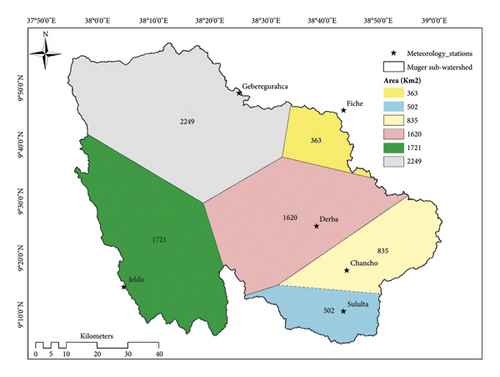
2.3. Temporal Dynamics Analysis
Rainfall in a specific region may vary in its frequency, pattern, and distribution through a time named as temporal dynamics of rainfall [8, 9, 33, 34]. There are various methods to check this variability which include the standardized anomaly index (SAI) to analyze the frequency and intensity of the precipitation, the coefficient of variation (CV) to estimate the seasonal and annual rainfall variation pattern, and the precipitation concentration index (PCI) to evaluate the distribution of seasonal and annual rainfall through a time.
2.3.1. Standard Anomaly Index (SAI)
According to [6, 40], the SAI is classified as extremely wet with an SAI value more than or equal to 2 and extremely dry with an SAI value less than or equal to −2, and other severity classes are described in Table 2.
2.3.2. Coefficient of Variation (CV)
2.3.3. Precipitation Concentration Index (PCI)
2.4. Trend Analysis
The trend is a significant change of climatic data over time which is detectable by parametric and nonparametric procedures while trend analysis of a time series consists of the magnitude of the trend and its statistical significance [13, 43]. In this study, statistical significance trend analysis was done by using the Man–Kendall test while the magnitude of the trend was determined by nonparametric Sen’s estimator method in modified forms (modifiedmk). The RStudio program is the most time-saving media to perform trend analysis [44–46]. So, RStudio was selected for this particular study.
2.4.1. Mann–Kendall’s (MK) Test
Statistically, the significance of the trend is assessed using the Z value. A positive value of Z shows an upwards (increasing) trend while a negative value indicates a downward (decreasing) trend.
2.4.2. Sen’s Slope Estimator Test
Based on the normal distribution and using the nonparametric procedure, we can achieve a two-sided confidence interval about the slope of 100(1−α) %. An increasing or upward trend is obtained if the value of Q(i, j) is positive, while the trend will be decreasing or downward if the value of is Q(i, j) negative.
3. Results and Discussion
3.1. Temporal Variability Analysis Results
The annual areal rainfall in the Muger subwatershed for 40 years recorded data range from 890 mm to 1716 mm, while rainfall of the main rainy season, summer (Kiremt) ranges from 564 mm to 1257 mm, and for the shortest rainy season, spring (Belg) ranges from 87 mm to 485 mm. The summer (Kiremt) season contributes about 74.5% of annual rainfall and the spring (Belg) season shears around 17.5% of the annual rainfall of the study area. Figure 3 depicts the monthly rainfall distribution of the Muger subwatershed with peaks in July and August. The crop production in Ethiopia including the Muger subwatershed depends on these two rainy seasons. Therefore, a small fluctuation in the rainfall amount, intensity, duration, onset days, and cessation days significantly affects the agricultural activities of farmers [12, 24, 28].
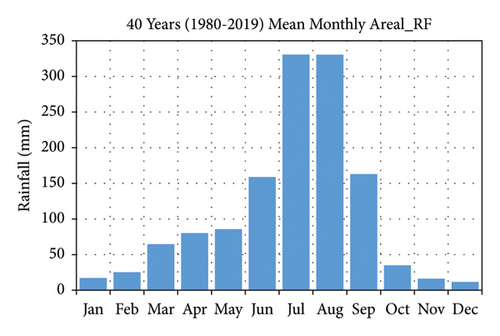
The seasonal and annual areal rainfall variation pattern of the study area in the considered time range (1980–2019) was detected by the coefficient of variation (CV). As a result, the CV value of annual rainfall is 13.43% which means the variation is low. The highly dynamic rainfall is recorded in winter (Bega) and spring (Belg) seasons with the CV value of 50.5% and 36%, respectively. The main valuable rainy season summer (Kiremt) in the study area shows low variability with a CV value of 13.7%. The CV of this study agreed with previous study conducted by Mohamed et al. [53] in the Blue Nile basin revealed that the CV is high in Kiremt rainfall which implies more interannual variability of Bega rainfall than Kiremt (coefficient of variation (CV)): Bega > Belg > Kiremt season.
The standardized anomaly index (SAI) result (Figure 4) depicts that 15% of the study period was relatively dry, another 15% was wet, and 70% was in the normal condition by considering the annual areal rainfall. As the result of SAI for annual rainfall, 1983 was an extremely dry year with a value of −2.42. Similarly, Upper Blue Nile faced extreme severe drought in the year 1980–2002 [54]. Furthermore, the annual and seasonal intensity and frequency of rainfall in the study area was represented in Figure 4.
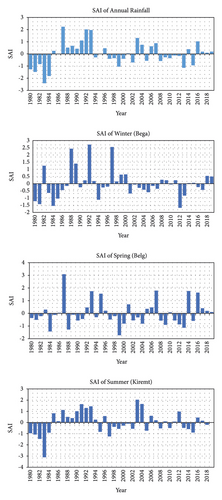
The results of the precipitation concentration index (PCI) depict that around 17.5% of annual rainfall was strongly in irregular distribution, 57.5% of annual areal rainfall was irregularly distributed, and 25% of the considered year was moderately distributed. Mohamed et al. [53] reported that 89.9% of rainfall was irregular to strongly irregular distribution in Upper Blue Nile basin. On the other hand, the seasonal (winter, spring, and summer) rainfall distribution of the study area shows strong irregularity distribution throughout the considered years.
3.2. Trend Analysis Results
The trend analysis was performed in RStudio using a modified version of Mann–Kendall and Spearman’s Rho trend test with a bias-corrected prewhitening technique. Hamed [55] proposed a prewhitening technique in which the slope and lag-1 serial correlation coefficient are simultaneously estimated. The lag-1 serial correlation coefficient is then corrected for bias before prewhitening.
As the result of MK trend analysis, the areal rainfall of the Muger subwatershed was decreased in the annual and summer (Kiremt) while increasing in winter (Bega) and spring (Belg) seasons with the slope presented in Table 3. The decreasing pattern of summer rainfall will affect agricultural practice since it is the most valuable seasonal rainfall in the Muger watershed. Most studies conducted in the Upper Blue Nile basin reported that the annual rainfall was decreasing trends [53, 54, 56–58]. According to the p value, the trend observed in the study area is insignificant.
| Statistical parameters | Annual | Winter (Bega) | Spring (Belg) | Summer (Kiremt) |
|---|---|---|---|---|
| Z value | −0.194 | 0.895 | 0.460 | −0.387 |
| p value | 0.85 | 0.37 | 0.65 | 0.70 |
| Prewhitened Sen’s slope | −0.44 | 0.54 | 0.27 | −0.64 |
| Sen’s slope | 1.46 | 0.63 | 0.19 | 0.87 |
| S | −17 | 75 | 39 | −33 |
| Var(S) | 6833.667 | 6833.67 | 6833.67 | 6833.67 |
| Tau | −0.023 | 0.10 | 0.053 | −0.045 |
Also, the trend graph as shown in Figure 5 support the results of the modified Mann–Kendall test.
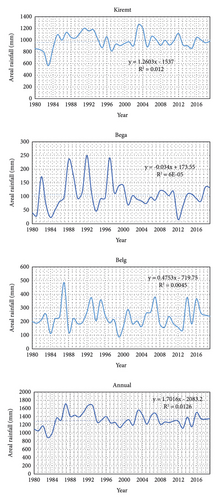
The decadal trends show that the areal rainfall of the Muger watershed pattern fluctuates; in the 80th (1980–1989), the areal rainfall was 12453.81 mm and increased to 13886.75 mm in the 90th (1990–1999) but it was reduced to 13386.74 mm in 100th (2000–2009) and 13042.97 mm in 110th (2010–2019). Generally, when compared the two decadal rainfall (90th and 100th) from the initial (80th), the areal rainfall shows an increasing trend (see Figure 6).
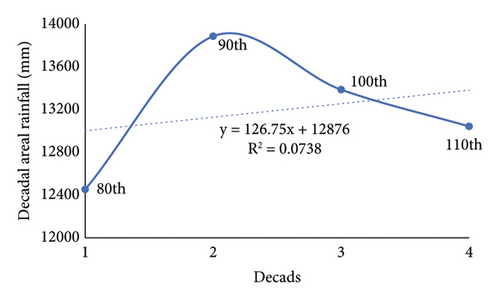
4. Conclusion
Analyzing the variability and trend of rainfall time series is necessary to provide a better understanding of rainfall patterns in a specific area. This study aimed to investigate temporal variability and trend in the seasonal and annual areal rainfall series recorded in the Muger subwatershed in the last four decades (1980–2019). The temporal variability of the areal rainfall in the study area was analyzed by a coefficient of variation (CV), standard anomaly index (SAI), and precipitation concentration index (PCI). The trend analysis was performed using modified Man–Kendall (modifiedmk) in the RStudio to detect the possible trends in the annual and seasonal areal rainfall.
The results of temporal dynamics analysis indicated that the areal rainfall is variable in pattern, frequency, and distribution. Similarly, modifiedmk tests in RStudio indicated that the areal rainfall of the Muger subwatershed showed a decreasing trend in the annual and summer (Kiremt) while increasing trend in winter (Bega) and spring (Belg) seasons. Therefore, the results of this study indicated that the most important rainfall season (Kiremt) is decreasing this may affect the agricultural productivity of the society.
Disclosure
The submitted work is original and has not been published elsewhere in any form or language (partially or in full).
Conflicts of Interest
The authors declare that they have no conflicts of interest.
Authors’ Contributions
All the authors have equal contribution.
Open Research
Data Availability
The data used to support the findings of this study are available on request from the corresponding author.



